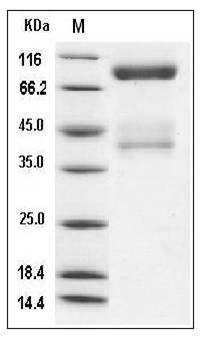-
Product Name
Canine c-Met/HGFR (His Tag) recombinant protein
- Documents
-
Description
Receptor tyrosine kinase that transduces signals from the extracellular matrix into the cytoplasm by binding to hepatocyte growth factor/HGF ligand. Regulates many physiological processes including proliferation, scattering, morphogenesis and survival. Ligand binding at the cell surface induces autophosphorylation of MET on its intracellular domain that provides docking sites for downstream signaling molecules. Following activation by ligand, interacts with the PI3-kinase subunit PIK3R1, PLCG1, SRC, GRB2, STAT3 or the adapter GAB1. Recruitment of these downstream effectors by MET leads to the activation of several signaling cascades including the RAS-ERK, PI3 kinase-AKT, or PLCgamma-PKC. The RAS-ERK activation is associated with the morphogenetic effects while PI3K/AKT coordinates prosurvival effects. During embryonic development, MET signaling plays a role in gastrulation, development and migration of muscles and neuronal precursors, angiogenesis and kidney formation. In adults, participates in wound healing as well as organ regeneration and tissue remodeling. Promotes also differentiation and proliferation of hematopoietic cells (By similarity).
-
Protein name
Hepatocyte growth factor receptor
-
Protein short names
C-MET; AUTS9; RCCP2; HGF; HGFR; MET; AI838057; PAR4
-
Uniprot ID
Q75ZY9
-
Gene Name
MET
-
Source/Expression Host
Human Cells
-
Expression Plasmid/cDNA
A DNA sequence encoding the extracellular domain of canine MET (NP_001002963.1) (Met 1-Leu 935) was expressed, with a polyhistidine tag at the N-terminus.
-
Protein Species
Canine
-
Molecular weight
The recombinant canine c-Met is a disulfide-linked heterodimer composed of proteolytically cleaved ? and ? subunits. Each ? and ? subunit together consists of 922 amino acids and has a predicted molecular mass of 103 (? =33 + ? =70) kDa. As a result of glycosylation, the apparent molecular mass of the canine c-Met is approximately 42-47 kDa and 85-95 kDa respectively in SDS-PAGE under reducing conditions.
-
Purity
> 95 % as determined by SDS-PAGE
-
Activity
1. Measured by its binding ability in a functional ELISA.
2. Immobilized human HGF (Cat:502454) at 10 μg/mL (100 μl/well) can bind canine c-MET (Cat:500965), The EC50 of canine c-MET (Cat:500965) is 7 ng/mL.
3. Immobilized canine MET-His at 10 μg/ml (100 μl/well) can bind biotinylated human HGF-His (Cat:10463-H08H), The EC50 of biotinylated human HGF-His (Cat:10463-H08H) is 0.11-0.25 μg/ml. -
Validations

Canine c-MET / HGFR Protein (His Tag) SDS-PAGE
Related Products / Services
Please note: All products are "FOR RESEARCH USE ONLY AND ARE NOT INTENDED FOR DIAGNOSTIC OR THERAPEUTIC USE"
